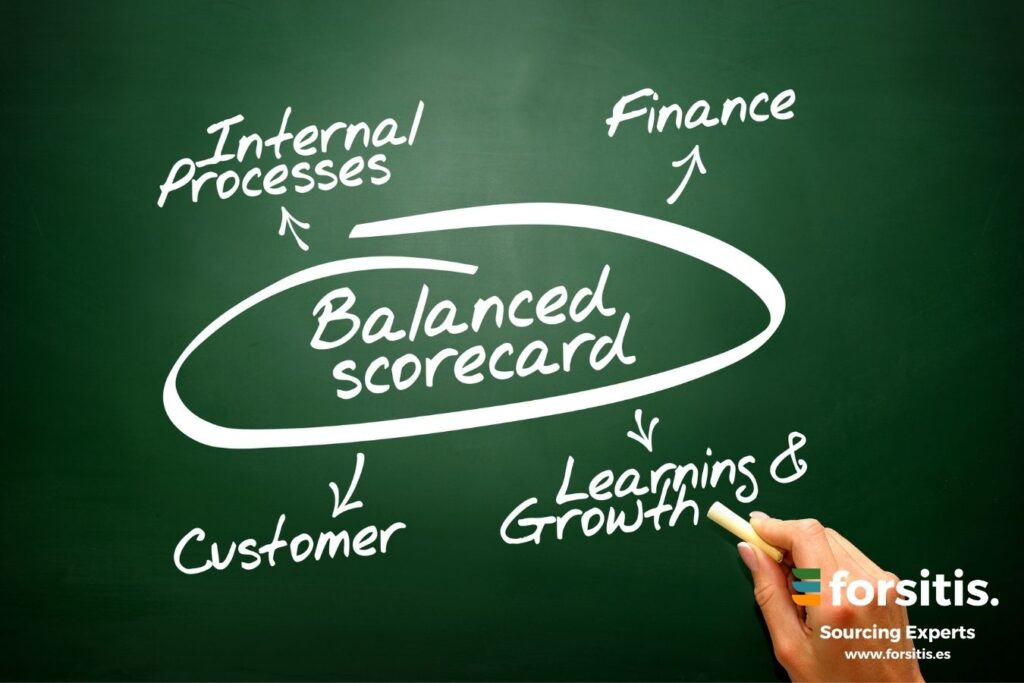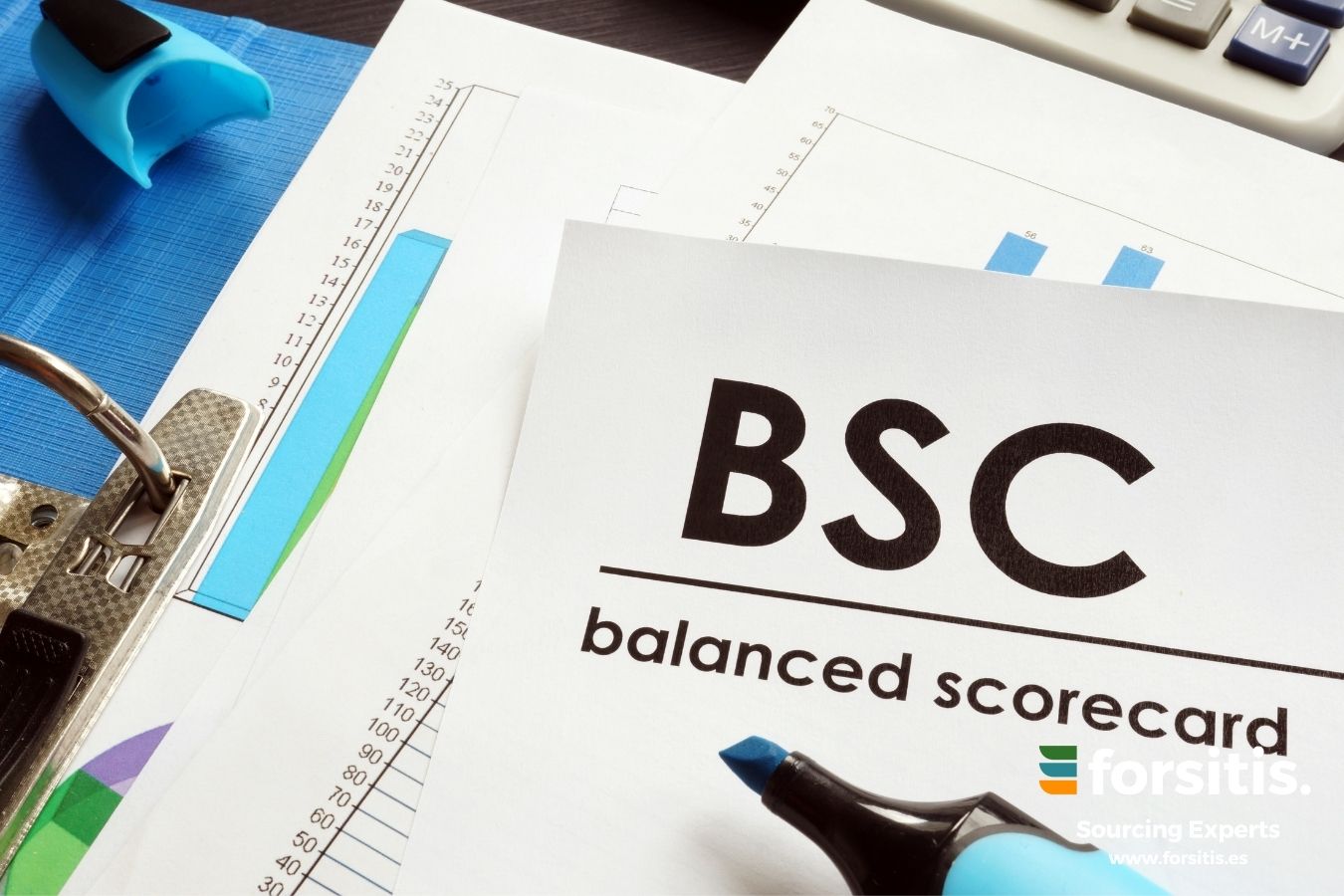It is very important for any company or business to know what is happening in real time. Having this global and real vision facilitates decision making, allowing the company to stay ahead of the competition, act quickly in the face of incidents, detect market trends and focus on the customer. That´s why using a Balanced Scorecard (BSC) will solve you some of this problems.
Using a Balanced scorecard to monitor all company parameters and have a real picture of what is happening inside and outside the company is the ideal tool for executives and managers. With the Balanced scorecard you will know what is the health of the company and its evolution from a general point of view.
In this text we will go deeper into what a balanced scorecard is, why its use is beneficial for a company and what indicators it uses.
What is a balanced scorecard
A Balanced Scorecard (BSC) is a business management tool used to measure the situation and evolution of a company from an overall perspective. The balanced scorecard provides a series of numerical and graphical indicators (control, financial, stock, and other areas of the company) that offer a general, objective and real-time vision that helps managers to make decisions.
Initially, dashboards were based exclusively on financial data (balance sheet and income statement) and were produced every 3 months. This financial view of the company limited the ability of managers to make decisions, as the data available to them represented the company in the past.
What is a scorecard based on?
The scorecard provides information on the company’s situation and its objectives, and is developed taking into account 4 interrelated perspectives:
- Financial. Through financial indicators, companies can maximize their value and growth, for example, they can increase sales or reduce the cost of some processes to be more productive. These values can be measured from the Balanced scorecard and see if the strategies to improve them are working properly.
- Customer. The scorecard should include metrics that measure the degree of relationship with customers. Some of these indicators are customer retention, customer satisfaction and customer profitability.
- Internal processes. A company’s internal processes add value to its products and services, and are also fundamental to any cost reduction strategy. The different types of company processes include day-to-day actions, management and customer relationship processes, creation and innovation processes and social processes.
- Training and development. From this perspective, the Balanced scorecard should provide information on the company’s intangible assets such as human capital (skills, abilities and competencies), information and communication capital (IT and communication networks and infrastructure) and organizational capital (the company’s capacity and organization to carry out the various processes).

What indicators should a Balanced scorecard include?
The various metrics or KPIs (indicators that measure performance) offered by a Balanced scorecard must be chosen with particular care. In order to have a global and real vision of what is happening in the company, these indicators must be represented both in figures and visually.
It is very useful to use the traffic light method to indicate the status of each indicator (green for those in a normal range, orange for those with a small deviation and red for those with a serious deviation). To determine the ranges of each indicator the company or professionals should study the market and its sector to mark the ranges of these metrics themselves.
The number of global indicators that a Balanced scorecard should show should be between 15 and 20 and should be aligned with the objectives set in the business strategy.
What are performance indicators?
BSCs make use of a series of parameters or metrics to show different information about the company. These indicators are known as KPIs or performance indicators.
Performance indicators show whether a process is being performed optimally (as it is supposed to be) or whether it is suffering some kind of deviation. These parameters are useful to know how processes are being performed, but they do not indicate the cause of possible deviations or variations in them.
The measurement of this type of indicators should be done frequently to always show in the scorecard the value that represents the current state, the past and allows us to make projections. Many indicators are immediate, while other long-term indicators need more time to be measured.
The representation of these values within a Balanced scorecard will be done in numerical and graphical form, to facilitate analysis and decision making.
Some examples of different indicators that can be included in a BSC are:
- Cash flow and value added as financial indicators.
- Brand recognition or customer retention as customer indicators.
- Manufacturing time or development cost as internal process indicators.
- Employee satisfaction and worker productivity as training and development indicators.
Each company -depending on its needs and activity- will decide which indicators to include in the scorecard, in order to reflect as reliably and realistically as possible the company’s situation taking into account all its areas.
Why use a Balanced scorecard
Companies should use an integrated scorecard because it allows them to design strategies to achieve interrelated objectives, quantifiable through indicators and related to business actions that involve the entire organization.
With the use of a Balanced scorecard, the company has real information on the company’s situation, which gives it a greater capacity to react to deviations or other types of problems. The scorecard will mark deviations from the objectives at a global level. Once detected, it will be necessary to go deeper to find the causes of such deviation.
Who uses a BSC
Decision-makers (managers, administrators, directors, managers, department heads, or any other employee with decision-making capacity) use the data provided by the Balanced scorecard to plan their strategies and design the tactics needed to achieve the objectives. However, the balanced scorecard is designed to enable company managers to make strategic decisions.
Within a company structure, it is possible to use a BSC focused on a department, showing indicators that make it easier to understand the current state of the department, for example, a human resources or sales BSC.
Large companies were the first to use scorecards to design and measure their business strategies, but it is not a tool exclusive to large corporations. In SMEs, a Balanced scorecard will probably include different indicators than a large company’s scorecard, but its usefulness for understanding the state of the company, designing strategies and increasing responsiveness is the same.
Advantages of using a Balanced scorecard
The advantages offered by the use of a scorecard within a business structure are innumerable. Among the most important we highlight:
It shows a global vision of the company’s situation.
A Balanced scorecard offers a global and detailed vision of the progress of the business, gathering different aspects that are fundamental for the good development of the company, not only focusing on financial variables. This global vision is based on real time data, so it shows a reliable situation of the company at that moment.
Facilitates strategy design and planning
The real-time overview of the company through the indicators of a scorecard makes it possible to design medium- and long-term strategies, as well as providing information for quick decision-making (short-term actions).
The data provided by a Balanced scorecard on the strategies generated are not only based on results, but also take into account other important variables that influence the company’s internal and external processes.
Provides intelligent information
A Balanced scorecard provides data on the company’s internal processes that help management, which does not necessarily have to be aware of the details of these processes, to make decisions.
Reduces potential market risks
With the use of a BSC you have access to a vision of the evolution of the company, being able to analyze trends and anticipate events, which greatly reduces the risks generated by the market.
Involves the organization with the business strategy
The scorecard includes indicators under the perspective of training and development that take into account human capital. Therefore, it provides information on satisfaction, performance and other parameters related to the company’s personnel, allowing measures to be taken to increase their involvement with the objectives set out in the strategy.
The data provided by the scorecard are of no use if the different departments do not implement them correctly, hence the great importance of involving all personnel in the company’s strategy.
Improve internal communication
The involvement of all employees in the company’s strategy translates into an improvement in the knowledge of objectives and communication among employees. Internal communication channels will have a greater flow in both directions.
Allows the success of the strategy to be assessed
The scorecard shows indicators that offer numerical values, through which you can see if the strategy being developed is achieving the objectives previously set. The BSC offers real and measurable data, making it a powerful and concrete tool for diagnosing the current state of the company.
Disadvantages of using a BSC
Using a scorecard has some risks that must be taken into account. Companies are dynamic entities that evolve and change over time. That is why choosing the right BSC is important, as well as updating it by adding or removing the necessary indicators.
A professional software for the management of a scorecard has an economic cost, usually a monthly fee. It is important to choose a BSC with a cost that is appropriate to the financial possibilities of the company, so that it does not represent a disproportionate expense.
A poor choice or interpretation of the scorecard indicators can lead to erroneous or unfavorable decisions for the company. For this reason, it is advisable to have professional advice on the configuration and interpretation of the scorecard, or to hire qualified professionals for this purpose.
Flexible and customizable Balanced scorecard
The main characteristic that a scorecard should offer is to provide a comprehensive view of the company’s situation and its evolution. However, companies are dynamic and even more so in today’s globalized market, where competition and innovation are constant.
It is necessary for the scorecard to be flexible and dynamic in this current context, allowing to customize its indicators in order to show the company’s reality at all times. A BSC cannot remain constant over time, but must be adaptable, showing indicators relevant to the current situation of the company in its environment.
Using a scorecard in a company makes it possible for the management or board of directors to make decisions more easily by having a global and real vision of the company’s situation. It is a very powerful business management tool that takes into account all the perspectives within an organization, and involves all the human capital in the objectives set out in the business strategy.


